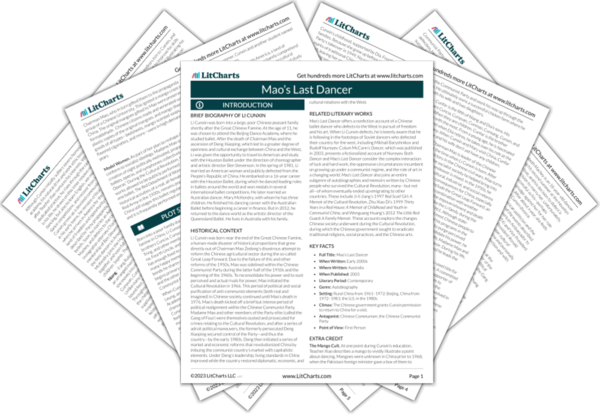Cultural Revolution Quotes in Mao’s Last Dancer
The numbers, our political heads explained, referred to 7 May 1970, when Madame Mao delivered a famous speech to the arts and education communities, using Chairman Mao’s philosophies to encourage all intellectuals to engage, both physically and mentally, with the three classes: peasants, workers, and soldiers. They were golden words to the Ministry of Culture, so they proposed that Madame Mao should be the artistic director of this new university, and that it should be located in the heart of the communes, where future artists could learn and work among the peasants every day. In such an isolated site, surrounded by communes and fields, students would be protected from any negative influences from the city. Madame Mao supported this idea, and the project quickly received the central government’s backing.

Unlock explanations and citation info for this and every other Mao’s Last Dancer quote.
Plus so much more...
Get LitCharts A+But in truth I didn’t really believe that playing with the birds would have caused any harm to Chairman Mao’s revolution at all. In truth I felt humiliated. I’d never had to do this in my old school.
My self-criticism passed the test easily, and my teacher and classmates burst into laughter when I read that last line. I also had to stand outside the classroom for a whole hour afterwards. “Cunxin, have you fed the poor birds yet?” the boys teased as they walked past, and my face burned with humiliation.
I hadn’t meant what I’d written. I hadn’t learned anything about serving Chairman Mao. All it made me realize was just how much freedom I was being denied. I would never be able to play with my beloved birds again. Now I was a bird trapped in a cage where even my feet had to conform to the rules.
There were no foreign books and almost all of the books were picture books—stories about foreign children written by Chinese authors, and the stories were always sad and tragic. Most of them were about struggling colored children in America and how the whites mistreated them, or they were about the struggle between good and evil. The good characters were always beautiful and handsome. The evil characters always had big crooked noses and fat ugly faces. They were Chaing Kaishek’s Guomindang officers and spies, or foreign enemies. I hated the evil guys and felt so sad for those impoverished colored children. I often shed sympathetic tears and I felt even more grateful for the heavenly life that Chairman Mao had given us. If our life was heavenly, then these poor children’s lives in America must be hell indeed.
“You can tell this ballet was designed by a capitalist,” our political head said. “He has glorified the rich and portrayed the peasants as whores. What a contrast to our model ballets! Our three classes of people are our heroes!”
We were all Mao’s faithful children and we all wholeheartedly agreed […] but I couldn’t help quietly admiring Albrecht’s brilliant dancing […].
During the Cultural Revolution almost every new creation in art was a joint project. […New] works had to have a Communist Party leader as one of the main creators […]. There would normally be more than one choreographer, set designer, lighting designer, and composer […]. Individualism was firmly discouraged. The Red Detachment of Women, which we’d performed for Madame Mao, was one of those ballets, and it took eight years to complete. But once I’d seen the beautiful Giselle I began to doubt The Red Detachment of Women was quite so artistically brilliant.
“I’m only one of millions of victims,” my brother explained to Mary. “I am, like so many people in China, still amazed at how badly I was manipulated and betrayed by Mao and the Gang of Four. The Red Guards of yesterday were the epitome of the communist spirit. Now we are searching for answers. We have to live with our injured pride and lost beliefs.”
I felt so much sorrow for Cuncia. I knew what he said was true—he had spent the best part of his youth pursuing nothing but propaganda. But the Cultural Revolution didn’t just rob him of his youth; it crushed and destroyed his spirit and his soul. His trust in society had vanished. Even his sacred family values had been called into question by Mao and the Cultural Revolution.












